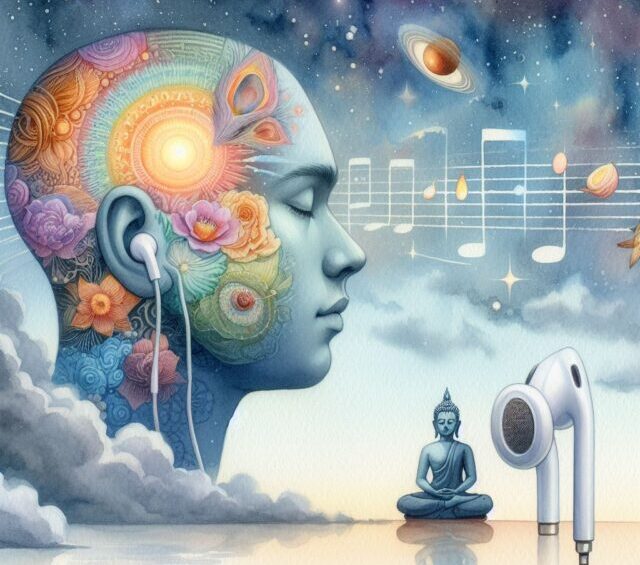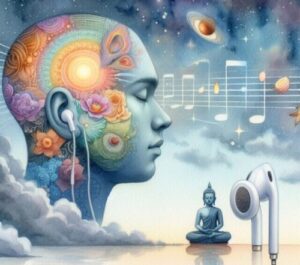
Introduction
As I consider the various aspects of being mindful, I realize just how much there is to cover. The human senses are critical in your self-development so your awareness should continue to grow and become a striking feature of your daily life.
This awareness will make your life happier and calmer and keep you in control. At the same time, being mindful will strongly affect your interactions on the internet, your work community, and the larger global population.
Listening/Hearing — not human-made.
Ears like eyes (see Mindfulness and Eye Care) are always ready to receive even if we’re sleeping. If you read this article, you link your auditory sense to something more significant than you or your work. Later in this article, I will introduce a technique that enables you to listen with your whole body and find complete peace in silent awareness. Surprisingly, silence is essential in listening and hearing healthfully and holistically.
A Brief History of the Auditory Sense

The bigger picture of Listening/Hearing may act as an inspiration to help transform your mindset. It may surprise you that our Earth’s world history and myth classics are full of the idea that sound can create matter. The human world materialized through the mechanism of sound – the creation stories in so many traditions involve sound as the most creative energy of all. For example, the Indian gods Vishnu, Brahma and Andra came into existence in such a way, and the Christian God created the world with words pronounced aloud.
Science has proved that making a particular combination of sounds near plants can increase growth and yield. On the contrary, the same combination can retard their growth and inhibit their yield.
Brahma, the central Hindu god pictured above, skillfully captured the vibrations of the supreme and so created the world as we know it.
Sound is capable of creation, preservation and destruction.
Selective Hearing
As you can deduce from above, we only hear what we want or can hear daily. So, most of us can greatly expand and enhance our auditory skills. Without digital or literary stimulation, our ancestors had highly developed hearing acuity. We can use our whole body to listen because the universe comprises sounds our spirits can resonate with.
This demonstrates how closely the sense of hearing and seeing are: both involve being aware that the material and all matter, whatever form, colour, type of resonance, etc., consists of atoms vibrating. This is pure physics.
So, when we listen or hear, being mindful (see Mindful Practices for Beginners) is an excellent time to understand how to apply this fact to our daily lives. But the key idea in all mindful practice is to increase your awareness of your environment both inside and outside.
The Importance of silence when being mindful Listening/Hearing
Witnessing our lives without getting too attached was mentioned in Mindfulness and Eye Care. This can bring great joy, and it applies to sound too.
Try it now:
Stand in your workspace
Soften the focus of your eyes
And deepen your breathing.
Little reminders to:
- sense your spine lengthening
- feel the heels of your feet going down into the Earth
- imagine the crown of your head going up into the blue sky
Then, just let your eyelids fall while you listen out into your environment.
Two Steps to becoming a witness in your life
Step 1:
Listen out around the far edge of your environment – outside your workspace.
(Listen for traffic noise, planes or helicopters, people’s voices, dogs barking, people moving around in other rooms of your home, etc. Just enjoy moving your attention around and be careful not to react but observe or witness what you can hear).
Step 2:
Then, move your attention inside your workspace and tune in to what you can detect there. (You may hear electricity buzzing or your PC activating, etc., but continue just witnessing and resist reacting or classifying what you are detecting).
Some teachers say deep Listening is:
“becoming aware of sound without any action associated with it.“
In a way, you need to be empty so that sounds can fill your environment, just like pure sound and vibrations. Remember that your ears, like your eyes, can always receive vibrations even when you are sleeping.
A mental image of thoughts compared with sounds/non-sounds
Did you know that ancient Indian philosophy interprets both thinking/thoughts and listening/sounds as a mountainous landscape:
The thoughts are the shady valleys between the snow-covered peaks, which are the complete silence.
So really, to appreciate sound, it helps to appreciate silence, a rare commodity in modern life.
Active Listening to speech—a soft skill when Being mindful
Active Listening requires the listener to hear, evaluate and interpret speech content. There are four types:
1. Paraphrasing
1. Repeat the essence of the message being spoken back to the speaker/group in different words = paraphrase
This demonstrates the listener’s concentration
2. Reflecting Feelings
Reflect on your feelings about what you are hearing
This validates the communication and creates a rapport between the transmitter and receiver.
3. Reflecting Meaning
Reflect the meaning of what you are hearing with words or non-verbal signals
This confirms your understanding and helps to focus on the facts of the message
4. Summative Reflection
Reflect or Summarize what you hear
This combines all 1, 2, + 3 and incorporates the listener’s views.
Other styles of listening Mindfully
There are 3 styles:
- Combative Listening — this is when you are waiting for mistakes and attack or interject
- Passive Listening — listening patiently with feeling and understanding
- Active Listening — verifying that the message has been heard and understood: the benefits of active listening are:
CombativeListening avoids misunderstandings
Passive Listening builds relationships + trust.
Active Listening Improves productivity and overcomes disagreement
Inhibition: one more technique
Imagine that the phone rings unexpectedly when you are working. You don’t want to be disturbed because you are concentrating on something and want to see it through. You may notice that you feel some tension somewhere in your body when the phone is ringing relentlessly. And, of course, to put yourself out of that misery, you eventually give in and pick it up.
So, once you have practised and are prepared to stop responding to the phone ringing, listen to it while not attaching yourself to it. Inhibit the tension, the tight muscle tone and the emotions, and just let it ring. It is so rarely going to be someone ringing that poses a threat to your safety or informs you of the death or accident of a loved one. And they will leave a message so you can ring them back.
Notice the change in your body as you witness the phone ringing as if it is ringing for someone else, and you just happen to be nearby. You can remain relaxed but dynamic without any unnecessary muscle tone, negative emotions or sense of obligation. You need to cultivate this inhibiting state in your workspace – Being mindful while listening/hearing.
Your mental health will inevitably deteriorate if you continue to mindlessly react to all the external pressures which insist on your working day.
6 practical tips when Listening/Hearing mindfully
- Maintain 60 DBS on devices at all times – maximum 80.
- Cut down on listening for long durations and take breaks often.
- Try to avoid wearing earphones in all your working sessions. I don’t use them at all – just good PC internal speakers and a desk mic to be sure I can be heard during conference calls, etc.
- Constant ear-phone wearing creates high temperature and humidity in your ears. This can lead to the build of bacteria and fungus and, inevitably, ear infections/hearing loss.
- Clean your ears often outside and in. Earwax is created by the inner ear to protect the sensitive eardrum. Still, it can build up gradually and needs to be removed. Go to get an ear check, or use a few drops of pure warm oil (olive, almond or coconut) to coax out the hardened balls of wax.
- Clean your earphones regularly — according to the manufacturer’s instructions. Never use earphones with rusty metallic parts.
- If your ears are blocked/painful for 24 hours, go immediately to the ER.
A final thought
Please remain a floating or impartial witness in all your interactions that require you to listen to a colleague or manager. Remember, it’s only a job! If you identify too vigorously, the problems or propositions will suck you in, fix or glue you to your work. Then you may be unable to let go quickly, hence insomnia, loss of appetite, etc.
Remember your choices are:
—being a floating but attentive witness OR identifying and becoming glued or fixated.
Just let the energy of your interactions flow smoothly like a bubbling stream around the obstacles out to the vast ocean where all streams lead.


